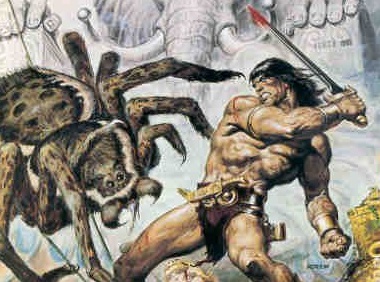As I mentioned earlier this week, a storyworld is defined by its premise, which is comprised of its setting, characters, conflict, and (I realize, after some consideration) tone.
We’ve already explored the tone of my still-unnamed fantasy world of giant spiders, so I’d like to tackle the next chunk of its premise: the setting.
Broadly speaking, the setting of this storyworld is like what you’ve been seeing in the blog images. While it’s not exactly Conan, it’s a world where Conan would feel at home.
To make a general rule of it, a storyworld’s setting includes the obvious (time and place, like Mrs. Jorgenson drilled in my head in seventh grade English), but also includes genre, scope, and at least one unique feature.
Genre
Yes, it’s a “fantasy” world, but “fantasy” is such a terribly broad term, it’s merely a good place to start defining the genre. Doubling down on the whole “kind of like Conan” thing, I’m going to say we’re in the “swords and sorcery” genre, home of Conan, Elric, the city of Lankhmar, and the weird tales of Clark Ashton Smith. As part of this genre, magic exists, but it’s rare, dangerous, and corrupting.
Time and Place
As a fantasy setting, we’re not concerned about the literal when and where of our unnamed spider world so much as its real-world equivalent. In this case, the time is “bronze age” – a broad era of low-tech civilization—and the place is… well… This is the part where I’d pull out the map, if I had one. There will be a map, maybe as soon as next week, but for now, let’s just say the “place” is a land of vaguely Mediterranean climate and varied geography.
Scope
This is not a geographically huge storyworld. It doesn’t encompass a whole planet or even a whole continent. Oh, there are continents, and it’s on a planet, but the scope of the world is relatively small, like the size of ancient Greece. Big enough for any spider-fighting stories you want to tell, but not overwhelming. It’s focused.
Unique Features
You mean aside from the giant spider invasion?
Okay, this is the vaguest of all setting elements, but I think it’s important to consider. What separates your near-future dystopian setting from the one next door? How is your steampunk horror setting different from mine?
Note that in a “real world” setting like modern-day New York City or London in the 1600s, it’s perfectly legitimate to have few or no unique features. In that case, the differentiation comes from character, conflict, and tone.
In a fantasy setting, one of the unique features should be its magic. For instance, I think that the people of our web-covered land specialize in creating potions from alien secretions found underground. The potions create all kinds of weird magical effect but tend to drive their users mad.
And Then…?
This is by no means an exhaustive list of things to consider when developing a setting. (If you’d like a sweet checklist, check this list.) Rather, this is merely an overview of the key elements of setting. This is the view from a mile up. Don’t worry, we’ll be getting down into the details of the spider world soon enough.
That’s setting and tone. Stop by next week when we tackle character and conflict… and maybe pick a name for this storyworld.

